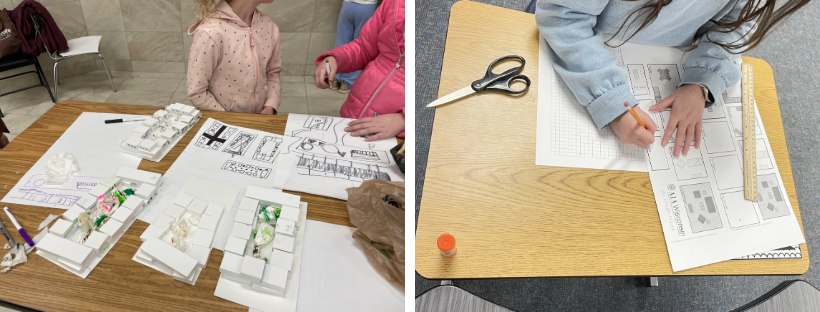Healthcare executives juggle decisions worth millions of dollars across multiple campuses while trying to predict a future that keeps changing. Aging facilities need updates, new technologies demand space, and patient needs shift faster than anyone can track. For health systems managing everything from rural Critical Access Hospitals to major medical centers, the old method of planning one facility at a time leaves critical gaps.
BWBR Principal Jason Nordling, Senior Planner Jessica Sweeney, and Principal Brian Zabloudil help health systems tackle this complexity through system-level strategic planning. Their work extends well past traditional facility master plans, taking on the task of aligning an entire network of care.
Thinking Bigger Than Buildings
Most people understand facility master planning—you examine one campus, identify what’s broken or outdated, then create a phased plan to fix it. System-level planning operates at a completely different scale.
“With system-level planning, you’re often thinking about a network of campuses,” Brian says. “You think about services that are interconnected, so multi-location emergency departments, multi-location surgery departments, and how they all work together.”
The scope can stretch across dozens of facilities spanning multiple states. Instead of a typical three-to-five-year timeline, these plans look 10 to 15 years ahead, mapping out decisions that affect thousands of patients and staff members.
Jessica brings operational insight that architects alone might miss. After working in healthcare for a decade before joining BWBR, she understands the ground-level challenges that influence major strategic decisions. “We get to really partner with our clients to think about that strategy piece—how are things changing, how is healthcare changing, how is their population growing or ebbing and flowing?”
Data Changes Everything
Jason has watched the planning process evolve as data analytics have become more sophisticated. “I can’t tell you how many times we’ve been involved in a project and trying to deal with a complex situation, either with a building or a series of buildings, because there was no forethought put into how things evolved,” he says.
Today, planners can analyze market trends, population forecasting, and utilization patterns with precision that would have been impossible even a few years ago. The real power comes from using that data to prevent problems rather than just responding to them.
“A lot of times these conversations at a system level—they are about what we are developing new in the future, but they also have 50 buildings with asset preservation needs as well,” Jason says. Knowing that a roof needs replacement in three years or that HVAC systems are nearing end-of-life allows for strategic capital planning instead of emergency spending.
Coming to Consensus
The most complex health systems often have the most complex politics. With stakeholders ranging from executives and providers to community members, reaching consensus becomes a significant challenge.
“Everyone has their own priorities, and decision-making can be a real challenge,” Brian says. “To some degree, we’re a mediator, facilitating the conversation and trying to bring different perspectives.”
At the heart of that process is trust. Jessica’s healthcare background gives her credibility that opens doors to deeper conversations. “Clients need to know that we’re listening to them,” she says. “They need to know that we are providing them good feedback and good information.”
That trust pays dividends when difficult decisions need to be made. Sometimes the right answer isn’t a new building—it’s reorganizing workflows or optimizing existing space. However, embracing change and new technologies can be a challenge for organizations, even when the benefits are clear. Staff who have worked the same way for decades need time to adjust.
“Most of the time, though, with time and incremental conversations, people come around to thinking about things differently,” Jason says. The key is providing proof of concept—showing how other facilities have successfully made similar transitions.
Jessica emphasizes the importance of keeping staff engaged. “We have to have that conversation and I think that’s inherent in change management. It’s just identifying the change, talking people through it as much as possible.”
The Staffing Reality
Staffing challenges often matter more than facility limitations. Jessica regularly sees this play out in planning sessions across the country.
“One of the biggest limiting factors in healthcare growth in almost every system we interact with is hiring and staffing,” she says. “When we’re looking at spaces or facilities, if we say what’s your limiting factor, what’s stopping you from growing, what’s stopping you from seeing more patients, space is sometimes indicated there, but oftentimes it’s staffing.”
This changes how planners think about growth strategies. Adding exam rooms means nothing if you can’t hire nurses to staff them. Sometimes the smarter investment is in workflow improvements that help existing staff work more efficiently.
Rural Healthcare’s Tough Questions
Rural healthcare creates some of the most difficult planning challenges. Jason frequently works with Critical Access Hospitals wrestling with whether they still need inpatient beds when their average daily census hovers around three patients.
“There’s always this huge reluctance to get rid of inpatient beds,” he says, even when the numbers suggest that resources might be better allocated elsewhere. The Rural Emergency Hospital program offers financial incentives for hospitals to convert to emergency-only facilities, but community and economic concerns often override the financial logic.
“I don’t know if the incentives are strong enough yet to make those changes,” Jason says. The economic impact of a hospital closure on a small community extends well past healthcare, affecting everything from property values to the ability to recruit other businesses.
Plans That Live and Breathe
The final output of system-level planning isn’t a glossy report that sits on a shelf. Brian emphasizes that successful plans must be dynamic.
“These plans can’t be static,” he says. “The strategy evolves almost immediately. We find that happen with clients where within three months, something that was in year six all of a sudden is pushed up to year one.”
The goal is to do enough foundational work that health system leaders can make adjustments on their own when unexpected opportunities or challenges arise. The process builds institutional knowledge and a decision-making framework that persists into the future.
When it Works
When system-level planning succeeds, it creates something rare: clarity about the future. Jason describes the relief that comes when leadership teams can see a clear roadmap ahead. “It gives them space to breathe,” he says. “When you lay the plan out and you’ve got everybody in the room, there’s a feeling that ‘We did some hard work here. It’s taken us months to achieve, but now we feel we’ve got this roadmap in front of us.’”
Jessica adds that the process itself creates value beyond the final plan. Departments that rarely communicate find themselves at the same table, building relationships that improve coordination long after the planning process ends.
The challenges never disappear entirely—healthcare changes too quickly for that. But with thoughtful system-level planning, health systems can make capital decisions with confidence, knowing they’re building for the future rather than just patching problems from the past.





